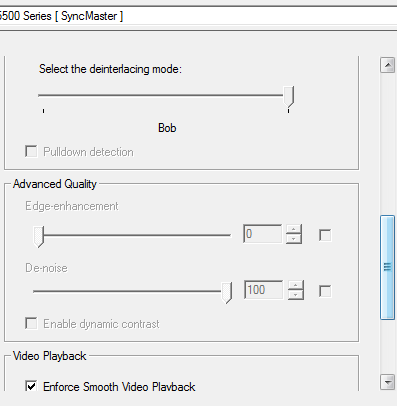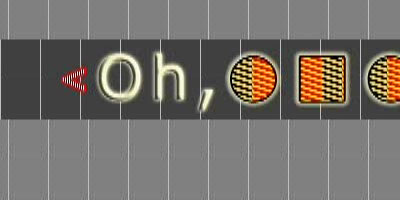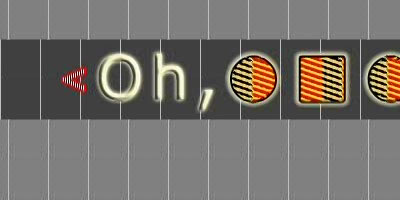The Final Word on the Best Radeon HTPC Card
by Ryan Smith on February 12, 2010 12:00 AM EST- Posted in
- Ryan's Ramblings
- GPUs
Since we published our reviews of the Radeon HD 5450 and the Radeon HD 5570, we have been going back and forth with AMD over the results of our video quality tests using the Cheese Slices test. Our initial results showed that neither the 5570 nor the 5450 had enough compute power to handle the full suite of post-processing abilities on 1080i video, the most important of which was Vector Adaptive deinterlacing. Since then, AMD has let us in on a few things that have changed that significantly, so let’s dive right in.
Enforce Smooth Video Playback (ESVP): The first thing that changed is that we finally got a complete answer on what Enforce Smooth Video Playback does. The short answer is that it’s an “idiot button” for users, to keep them from using so many post-processing settings on low-end video cards that It causes frames to drop.
Specifically, AMD has their own internal test suite that they use to test their low-end cards to see what they’re capable of when it comes to post-processing. If those cards are incapable of a certain feature(s) at certain settings, then using ESVP will have the driver quietly disable those features, so that only the features the card can keep up with are used. In essence, ESVP is a list of monitor-resolution/feature/video-resolution combinations where features need to be disabled when ESVP is active. This is all done driver side, and is not a 5000-series only feature as some people have speculated.
Anyhow, ESVP is not essential to the operation of the video card. It’s not doing anything beside disabling features on cards & situations where there are known issues, which means it’s not doing anything on faster cards; turning it on or off on a 5570 or better has no impact on anything whatsoever. However with that in mind, we tested it and found that it shouldn’t be disabled. On faster cards it’s not hurting anything (since it doesn’t have anything on its list to disable) and on slower cards we’ve found that AMD’s settings are in fact right on the nose. For example if we forced Vector Adaptive deinterlacing on the 5450 at 2560x1600, the card would drop 3 frames over the span of the Cheese Slices test. ESVP was doing the right thing by disabling it. Thus as far as we can tell, any feature disabled with ESVP turned on is disabled for a good reason.
With that in mind, we’re going to stick to our original suggestion of leaving ESVP enabled on all AMD cards. Enthusiasts can turn it off and tweak things if they want to, but AMD looks to have done a solid job profiling their cards – if you try to outsmart ESVP, you’re probably going to be dropping frames in doing so.
Radeon HD 5570: As we noted earlier, the 5570 original failed our Cheese Slices test. After AMD’s engineers looked in to it, it turns out that the drivers sampled with the card (ATI_8.69_RC3_Win7_Vista_Jan14) had a 5570-specific bug when ESVP was enabled. If you recall our review of the card, enabling ESVP would forcibly disable all post-processing and advanced deinterlacing features on the 5570, both internally and in the Catalyst Control Center itself. That was the bug – ESVP wasn’t supposed to be disabling anything.

The old AVIVO control panel on the Radeon HD 5570
AMD has since provided us with a newer build of their drivers (ATI_Win7_Vista_8.692RC2_Feb10, available from AMD here) which correct this issue. ESVP no longer blocks the operation of any post-processing features.
We went ahead and tested this driver in-depth, and the driver does indeed correct the issue. The 5570 is able to use all post-processing and advanced deinterlacing features with ESVP enabled and disabled. The quality was just as good as the 5670 (we would expect no less) and we found no evidence of the card dropping any frames.

Old Drivers: Radeon 5570 Deinterlacing

New Drivers: Radeon 5570 Deinterlacing
Thus as far as we can tell, the 5570 is in fact the perfect Radeon HTPC card that we have been looking for. It’s the cheapest, smallest, and coolest running 5000-series card that can offer the full suite of post-processing abilities, and of course it has the 5000-series’s audio bitstreaming capabilities. Since the whole point of this exercise was to identify the lowest 5000-series card that was still perfect for HTPC use, we have found it. And the best part is it even fits in a low-profile case.
Radeon HD 5450: While the driver bug in the earlier driver set only affected the 5570, in the process we learned something that had an impact on the 5450. As we discussed previous with ESVP, it takes in to consideration the resolution of the monitor along with the resolution of the video (i.e. is it HD) and the features requested. It turns out that we were inadvertently causing the 5450 to do worse than what it’s capable of.
For our testing, we use a Samsung SyncMaster 305T 30” LCD. The 305T is a bit unusual in that it doesn’t have a built-in scaler, so we ran our desktop at the full 2560x1600 resolution for the Cheese Slices test since we can’t do 1:1 pixel mapping of a lower resolution. This allowed us to run Cheese Slices in a window unscaled.
It turns out that the difference between rendering a 1920x1200 desktop and a 2560x1600 desktop is enough to make the 5450 start dropping frames when Vector Adaptive deinterlacing is in use. If we forced the issue by disabling ESVP, we would see a few frames get dropped in the Cheese Slices test when running at 2560x1600, but not at 1920x1200. This is actually something AMD was aware of, and as we just found out AMD has ESVP disable Vector Adaptive deinterlacing on a 2560x1600 desktop, but leaves it enabled at 1920x1200. Or in other words, the 5450 has enough compute power to do Vector Adaptive deinterlacing at HD desktop resolutions, just not at resolutions above that.

1920x1200: Radeon 5450 Deinterlacing
The important thing here is that HDTVs still top out at 1920x1080 – you (okay, most of you) wouldn’t be running a bigger display as an HDTV. Hence if we hooked this up to an HDTV via HDMI, we would be using a resolution below 2560x1600, and the 5450 would have used Vector Adaptive deinterlacing on all media. Our poor results in Cheese Slices had more to do with our desktop resolution than it did the abilities of the card.
With that said, there is one catch: the 5450 doesn’t have enough compute power to do any further post-processing on 1080i video besides Vector Adaptive deinterlacing. Just doing the decoding and that deinterlacing requires everything the 5450 can squeeze out, which means there’s nothing left for edge enhancement, de-noise, dynamic contrast, etc. So while the 5450 is a very capable HTPC card (more so than we first thought), it is not the perfect HTPC card like the 5570. If you need every last bell & whistle, the 5450 isn’t quite up to the task. But with Vector Adaptive deinterlacing working, it’s a reasonable expectation that the 5450 offers enough for most people – compared to Vector Adaptive deinterlacing, it’s in our own experience that the other post-processing features go unused most of the time.
So the 5450 is still the almost-perfect HTPC card, but it’s actually quite close. Unless you need more than Vector Adaptive deinterlacing, the 5450 would be as good of a fit as the 5570. To that end it’s the cheapest of the 5000-series, and it’s passively cooled, which certainly has its advantages.
Other Issues: We have had several HTPC enthusiasts email us over the last week asking about various features or complaining about various issues they have encountered. We’ve seen one particularly good thread over at AVSForum that lists out these issues, and while we don’t consider any of these to be nearly as significant as the earlier ESVP & deinterlacing oversights, we have passed the list on to AMD. At the very least, it’s something to take in to consideration if you’re going the HTPC route.










53 Comments
View All Comments
Rick83 - Saturday, February 13, 2010 - link
And then there's also the issue of upscaling 720p content to 1080p, which, if the 5570 has upscaling issues already, will probably tax a poor 5450 quite a bit too?dagamer34 - Saturday, February 13, 2010 - link
It's capable upto 1080p. It failed when testing 2560x1600 on a 30" Display, which no HDTV has that kind of resolution (and makes it a mostly moot point for 99.9% of people).kleshodnic - Saturday, February 13, 2010 - link
You didn't read my post. I specifically mentioned the 5450 working with all the enhancements at 720P. I know from the article the 5570 will....Iketh - Saturday, February 13, 2010 - link
i feel like punching a babyMazlov - Friday, February 12, 2010 - link
Thanks for the update, Ryan. I was a bit concerned with the initial test result of both the 5450 and 5570. I have been using a 4550 with Vector Adaptive Deinterlacing enabled for quite some time now, and was more than a bit surprised with your initial results.The htpc articles on AT have been very useful for many htpc enthousiasts, but I wonder why you would use such an odd resolution for your tests? It is my experience that most htpc users hooh their machine up to an HD (1920*1080) TV, not a pc monitor.
Ryan Smith - Friday, February 12, 2010 - link
Since all the testing is done in my office, it's done on the 30" monitor. My TV is actually an RP-CRT that doesn't take digital, so I can't test most of these cards on that since they don't have component out.At the time, there didn't seem to be an issue with doing this on the 30" monitor at 2560x1600; clearly that's wrong. We'll still be doing future tests on the monitor, but it'll either be 1920x1200 or 1920x1080 (likely the latter as long as scaling doesn't become an issue).
msa4033 - Friday, March 12, 2010 - link
It may be interesting to find out how the 5450 handles higher resolutions or other post processing features with CrossfireX enabled on say an 890GX or 785G board.russellwhitehead - Sunday, February 14, 2010 - link
Good article Ryan. Are you planning on running the core i3 530 through the 'cheese slice' test? I think it would be interesting to see if the new Intel graphics could cope.mataichi - Tuesday, February 16, 2010 - link
2nd that request.MGSsancho - Monday, February 15, 2010 - link
a budget htpc that is possible passive or silent and stylish writeup would be usefull. grab minimum parts needed to make a htpc that does just the basics